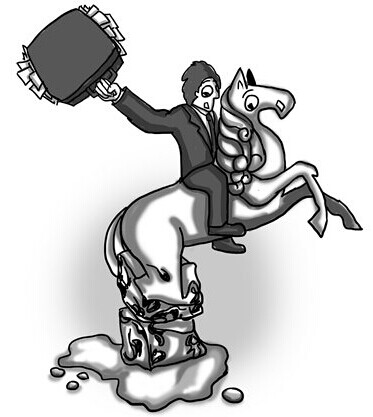

Illustration: Lu Ting/GT
A record 100 Chinese corporations made the Fortune Global 500 list this year, including 91 companies from the Chinese mainland.
The list shows that Chinese companies are rising in international stature. However, according to a report from the China Business News this week, 16 of the Chinese mainland companies on the list ran in the red in 2013. By comparison, there were only four US companies on the list that ran at a deficit.
These companies won high positions on the list based on their total assets and average revenues, but they lagged behind other companies in terms of profit.
For example, the 95 companies based on the Chinese mainland and in Hong Kong earned an average profit of $3.22 billion over the past fiscal year, below the average of $3.91 billion for all the companies on the list, according to media reports.
Chinese mainland companies also employed more workers to earn their profits. The Chinese mainland companies on the list had 190,000 employees on average, well above the average of 130,000 workers for all the companies on the list.
It is obvious that there are huge gaps in efficiency between mainland companies and their international competitors. To catch up, mainland companies should not only concentrate on expanding their size, but also focus on boosting their competitiveness.
Among the companies on the Fortune Global 500, there were 16 from the mainland that had a total deficit of 37.7 billion yuan ($6.11 billion) in 2013. Most of these companies are in industries suffering from overcapacity, such as coal and steel. They include Ansteel Group, Aluminum Corp of China and Kailuan Group. All 16 companies used to be industrial powerhouses, but overcapacity problems in their industries have taken a toll.
The central government has taken note of the overcapacity problems. It has issued calls for companies in these industries to upgrade to more advanced technology to improve productivity and reduce carbon emissions.
During this period of adjustment, many companies have sought to boost their productivity through mergers and acquisitions, which has left many of them heavily in debt, according to a report in June by China Chengxin?International?Credit?Rating?Co.
The report also mentioned that many State-owned enterprises (SOEs) have trouble controlling costs.
Indeed, most of the Chinese companies made the Fortune Global 500 list simply because of their size, which was the result of the aforementioned mergers and asset restructuring.
For instance, Ansteel Group was born of the merger of Anshan Iron and Steel Group Corp and Panzhihua Iron and Steel Group Corp in 2010. Hebei Iron and Steel Group was the result of the merger of Tangshan Iron and Steel Group Corp and Handan Iron and Steel Group Corp in 2008.
It is easy to build a giant company through mergers and acquisitions, but without long-term planning, the combined company is likely to face a host of problems, particularly in industries rife with spare capacity.
For instance, Hebei Iron and Steel Group has made the Fortune Global 500 list for six straight years. The company produced as much as 42.8 million tons of crude steel in 2013, the most of any company in China. Still, the company reported a net loss of $138 million last year. Scale doesn't necessarily translate into profit. A company has to hone a competitive edge.
Losses haven't been limited to companies in industries struggling with overcapacity. Three other mainland firms also reported losses recently, including COSCO Group and China National Chemical Corp.
COSCO reported a deficit of nearly 2.28 billion yuan in the first half of this year due in part to the sluggish international shipping market.
It should also be noted that the Beijing-based oil giant Sinopec Ltd became the first Chinese company to break into the Fortune Global 500's top three, trailing US retailer Wal-Mart Stores Inc and Royal Dutch Shell.
China National Petroleum Corp and State Grid Corporation of China also made the top 10. But they are SOEs in industries monopolized by the State.
These companies on the list highlight China's growing economic strength. However, they still need to prove they can be profitable in a competitive market.
Top Chinese companies grow, but face bottlenecks
2014-09-03Sinopec leads Top 500 Chinese Enterprises list
2014-09-02China‘s Fortune 500 companies weak in profitability
2014-07-09Copyright ©1999-2018
Chinanews.com. All rights reserved.
Reproduction in whole or in part without permission is prohibited.